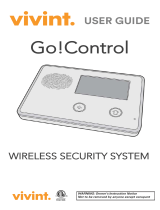
Chapter 4
4.0 The PowerSeries Neo Security System
Your PowerSeries Neo has been designed to provide you with the greatest possible flexibility and convenience. Read this manual
carefully and have your installer instruct you on how to operate your system and which features have been implemented in your sys-
tem. All users of this system should be equally instructed in its use. Fill out section "System Information" with all of your zone
information and access codes and store this manual in a safe place for future reference.
Note:The PowerSeries Neo security system includes specific false alarm reduction features and is classified in accordance with
ANSI/ SIA CP-01-2010 Control Panel Standard - Features for False Alarm Reduction. Please consult your installer for further
information regarding the false alarm reduction features built into your system as all are not covered in this manual.
4.1 General System Operation
Your security system is made up of a PowerSeries Neo control panel, one or more keypads and various sensors and detectors. The
control panel will be mounted out of the way in a utility closet or in a basement. The metal cabinet contains the system electronics,
fuses and standby battery.
All the keypads have an audible indicator and command entry keys. LED keypads have a group of zone and system status lights.
LCD keypads have an alphanumeric liquid crystal display (LCD). The keypad is used to send commands to the system and to dis-
play the current system status. The keypad(s) will be mounted in a convenient location inside the protected premises close to the
entry/exit door(s). The security system has several zones of area protection and each of these zones is connected to one or more
sensors (motion detectors, glassbreak detectors, door contacts, etc.). A sensor in alarm is indicated by the corresponding zone lights
flashing on an LED keypad or by messages on the LCD keypad.
Note:Only the installer or service professional shall have access to the control panel.
4.2 Carbon Monoxide Detection
This equipment is capable of monitoring carbon monoxide detectors and providing a warning if carbon monoxide is detected. Please
read the Family Escape Planning guidelines in this manual and instructions that are available with the carbon monoxide detector.
Note:Must be enabled and configured by installer.
Note:The equipment should be installed in accordance with NFPA 720.
4.3 Fire Detection
This equipment is capable of monitoring fire detection devices such as smoke detectors and providing a warning if a fire condition
is detected. Good fire detection depends on having adequate number of detectors placed in appropriate locations. This equipment
should be installed in accordance with NFPA 72 (N.F.P.A., Batterymarch Park, Quincey MA 02269). Carefully review the Family
Escape Planning guidelines in this manual.
Note:Must be enabled and configured by installer.
4.4 Testing Your System
Tests all system keypad LEDs, keypad sounders, bells and/or sirens.
To ensure that your system continues to function as intended, you must test your system weekly.
IMPORTANT:For UL HOME HEALTH CARE listed applications the system shall also be tested weekly without AC power.
To remove AC from the control unit, remove the screw from the restraining tab of the plug in adapter and remove the adapter
from AC outlet. After completing the test of the unit using only the battery backup source, reconnect the plug in adapter and attach
the screw through the restraining tab so that the adapter is securely attached to the outlet.
IMPORTANT:Should your system fail to function properly. contact your installation company.
IMPORTANT:All smoke detectors must be tested by your smoke detector installer once per year.
To Perform a Keypad and Siren Test LCD Display
1. From the Ready state press [*][6] and enter the [Master Code] to access User Func-
tions.
Press (*) for <>
User Functions
2. Press [04] or use the scroll keys to navigate to System Test and press [*]. The system
activates all keypad sounders, bells/sirens and keypad LEDs for two seconds.
Press (*) for <>
System Test
3. To go back to the Ready state press [#].
4.5 Monitoring
This system is capable of transmitting alarms, troubles and emergency information. If you initiate an alarm by mistake, imme-
diately call the central station to prevent an unnecessary response.
Note:For CP-01 systems, the monitoring function must be enabled by the installer before it becomes functional. There is a com-
municator delay of 30 seconds in this control panel. It can be removed, or it can be increased up to 45 seconds, at the option of the
end-user by consulting with the installer.
- 15 -























